Books we worked on
Each book reflects the knowledge, experience, and values of the author. The writer's opinion on the form and/or content of the book may not coincide with the author's.
Our collaboration is mentioned by authors in the forewords or acknowledgments.
The book is added to this page six months after the initial publication.
Phoenix's Fireteam. Stop the Enemy

Author: Petro Shevchenko, journalist, financial analyst at NV Business, veteran of the Russo-Ukrainian war.
Publisher: Folio.
Number of pages: 128.
ISBN: 978-617-551-783-3.
The main question the book answers: what were the first months of Russia's full-scale invasion of Ukraine like?
Some related questions: why did a suburban Kyiv resident, who had never served in the army, volunteer for the front? How were recruits trained in the first months of the full-scale war? How can one become a professional soldier in just six months? Why is it hard to return to civilian life after the frontlines?
Quotes from the book:
"On Saturday, early in the morning, I had a phone conversation with my neighbor (...)
— Petro, you need to leave this place because tomorrow it will be hell here, — said Yuriy Ivanovych to me.
— No, what hell, come on, this will end soon, — I replied.
That same day, there were issues with food supplies, bread disappeared from the stores. It was reported that food was running out in the maternity hospital and the orphanage in Vorzel. I started volunteering for them, driving around the area to collect food. The mobile connection was still working, and my wife was giving me addresses where I could pick up supplies.""We hid in the greenery, not understanding what awaited us or what to do. Somehow, we figured out on our own that we needed to dig trenches or foxholes. While we were looking around, we realized that this area had already been hit several times."
"Nobody moved at night — it was very dangerous because you could be shot without warning. So, I stepped away from our position, turned on my flashlight, and stood there. Kukhar was shouting, ‘Left!’ ‘Right!’ I followed his directions as he adjusted the mortar. Suddenly, I hear someone behind me noisily crashing through the bushes. I look around, shining my light through the shrubs. Suddenly, everything goes silent. I shout, ‘Kukhar! You hear me?!’ but he doesn’t respond. I turn the light back to the compass, and there he is, sitting in the trench with everyone else. He thought an enemy reconnaissance and sabotage group had attacked us, so he ran off and hid in the trench without even telling me. Turns out, it was probably just a wild animal that scared us."
"It was my first time at war, my first time leading such a team, and my commander was a young, inexperienced person."
"Right before we left, a Krishna devotee unexpectedly showed up. He was very odd — he didn’t even have any gear because his religion forbids killing.
‘Where did you come from?’ the commander asked him.
‘I was sent to your battery,’ the Krishna devotee replied.
What could we say? They took him in and gave him the callsign 'Krishna.' When we were traveling by train from the Cherkasy region, he still didn’t know what lay ahead and kept saying, ‘That’s it, guys, we’re going to end the war.’"
My Business — My Rules, 2023
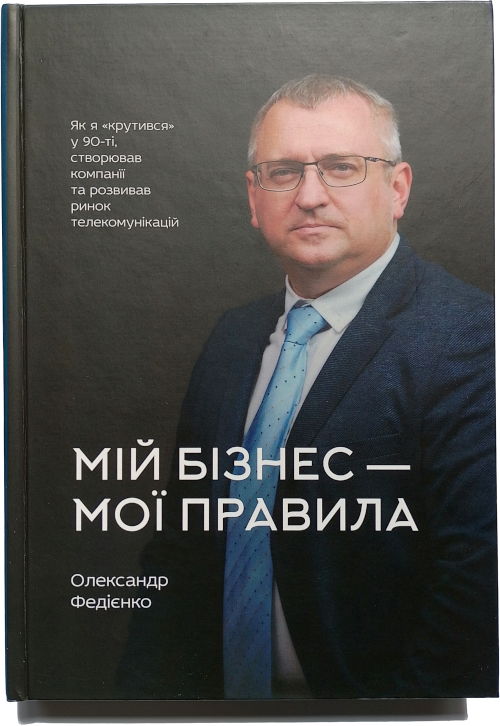
Author: Oleksandr Fediyenko, entrepreneur, public figure, owner of the company "IMK," former head of the Internet Association of Ukraine, Member of Parliament of Ukraine in the 9th convocation of the Verkhovna Rada of Ukraine.
Publisher: 7BC.
Number of pages: 244.
ISBN: 978-617-549-157-7.
The main question the book answers: How to move a small company into the big league of business.
Some related questions: How to build relationships with employees? Why is it sometimes necessary to fire the entire team? How to acquire corporate clients? How to become a long-term player in business? Why is it better to be an owner rather than a co-owner? How to always keep promises? Why is lobbying for laws necessary?
Quotes from the book:
“Sometimes a realistic view is hindered by bragging in front of fellow business owners, who also claim that they have the perfect company.”
“A vibrant street life and sports in my youth shaped another of my rules: always look your conversation partner directly in the eyes without looking away. The stronger the person, the harder this is to do, and for this reason, it’s the best way to show that you are the top dog.”
"I don’t understand how an employee can come and say, 'I want more money,' and when asked to justify their request, respond with something like, 'I’ve been working here for over seven years.' In such cases, I reply, 'Well, and for that, we’ve been paying you a steady and regular salary. What do you want to earn more for? Do you want to take on a larger workload or more responsibility?'"
“Don't lie to yourself or others with phrases like ‘we are one team.’ As long as supervisors and subordinates exist, they cannot be on the same team. Employees must be one team, and the manager is not a player of the team, but its coach.”
"A company that lacks a culture of creating and enforcing rules, especially rules of ethics and quality standards, is doomed to remain niche, crawl along, degrade, and self-destruct."
"Safety is an inconvenience; enhanced safety is enhanced inconvenience."
"To combat boredom and routine, I recommend shaking things up for the team. And I don’t mean a nature trip once a year. For example, I organized 'mask raids' several times — just like the real deal: all employees were herded into one room, forced face-down on the floor, and the adrenaline was so high it was hard to breathe."
The Time of Ownership, 2021
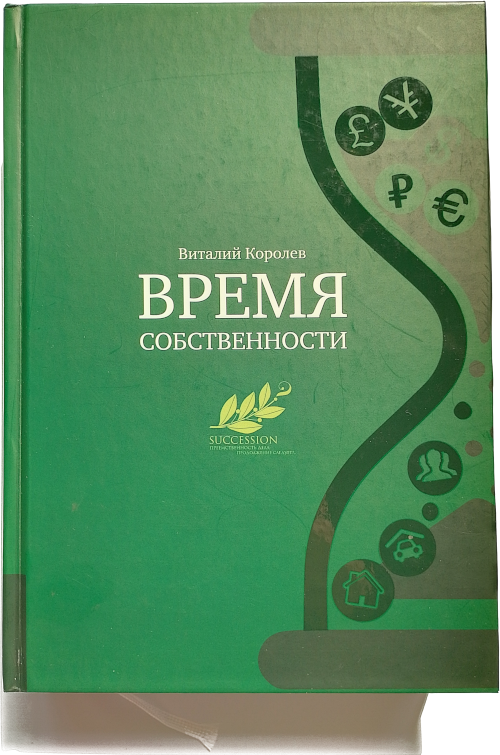
Author: Vitaly Korolev, management and ownership succession consultant; Doctor of Business Administration and member of the British Academy of Business; founder of the Succession project (links to web archive).
Publisher: Olymp-Business. An excerpt from the book, reviews and feedback on the publisher's website (web archive).
Number of pages: 752.
ISBN: 978-5-9693-0471-0.
Information about the book and our participation in the work on it on the author's website (in Russian):
"Special thanks to Nataliia Tolmachova and Maksym Momot (pr-kniga.com) for their huge help in structuring the material scattered in my publications, presentations, diplomas and dissertation, and preparing the first version of the manuscript, which allowed me to see the scope of the work in its entirety and organize a systematic editing process."
The main question that the book answers is: how to ensure business continuity with the tools of corporate governance.
Some related questions are: how can an owner define himself, what he wants from a business and provide himself with options? Why should the owner, not the company, be at the center of the “stakeholder environment”? How many roles can an owner play in a business? What is the difference between an efficient and a large-scale business? And effective and large-scale owner? Why is the “boss” always wrong? What is the difference between corporate governance and corporate management? How to put corporate governance tools into practice?
Quotes from the book:
“A 50% plus one share package makes you an owner, while 50% minus one share makes you at best a ‘junior partner’ and at worst an ‘unhappy minority’.”
“The first step to making a business work for you is to start thinking in terms of roles, i.e. activities that an owner can perform in a business, given his or her ownership status. At the same time, we need to remember that the role of the entrepreneur is always necessary for the business to remain competitive.”
“The owner's efficiency should be evaluated in the context of the different roles he or she performs: as an entrepreneur actively involved in management in addition to solving current issues, or as a capitalist focused on passive income, or as a top manager performing day-to-day management, if the owner performs this role as well.”
“Ownership efficiency is the financial return per hour of time spent by the owner of the company on ownership activities.”
“The criterion is quite simple: when the owner's passive dividend income as a capitalist equals his managerial income earned through hard work, then it is time to think about a system that allows the owner to move from operational management to strategic management.”
“For a salaried manager moving up the hierarchical ladder, the pinnacle of a company's career is the CEO position. For a business founder, it is often the starting position, the beginning of his or her career.”
“The better management book teaches owners how to be managers, not owners.”
“Stepping away from current management does not automatically imply stepping out of management per se. Quite the opposite: leaving one type of management automatically implies a transition to another type of management. As a rule, if an owner 'moves away from operational management', he does not abandon management altogether, but starts to engage in strategic management, and if he moves away from strategic management, he moves to strategic control of the business.”
“The company is run by managers, and corporate governance is needed by owners to manage relations with managers and to ensure that the business is transferred to a new owner (through sale or inheritance). In fact, corporate governance is “shareholder management” and the main tool for managing owner performance, not the business. It is also a way to make the business self-sufficient.”
“Who can do without corporate governance? Only a managing owner who owns the company 100%, provided he has no plans to step aside, inherit the business, sell or start a new business, and if he is not inclined to change decisions for a dozen or so years. You might also add “if the owner doesn't plan to get sick and die suddenly.”
“The basic tool of the owner of any company I call not corporate management, but corporate governance”.
Gett. Service With Meaning, 2019
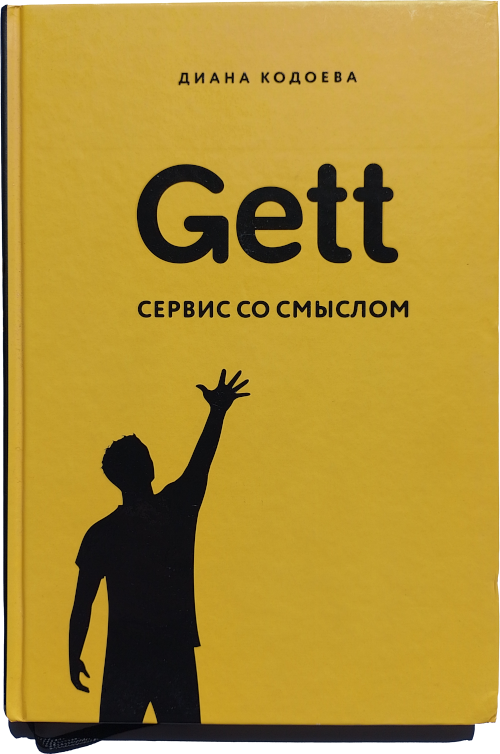
Author: Diana Kodoeva, ex-head of Gett's Customer Service Department in Russia; consultant on customer service and operational efficiency.
Publisher: Bombora. Excerpt of the book on the publisher's website.
Number of pages: 176.
ISBN: 978-5-04-101346-2.
The main question the book answers is: how to create a customer service organization with zero turnover and high operational efficiency.
Some related questions are: how to eliminate formulaic communication and give help desk professionals the freedom to make decisions? How to customize the standard grading system? How to correctly calculate the workload for specialists when working 24/7? How to avoid typical scaling mistakes?
Quotes from the book:
“If a company is incapable of taking care of employees, it is incapable of taking care of customers.”
“The goals I set sounded fantastic: 100% handling of communication lines, response time - up to 20 seconds, wow story from every contact, freedom of decisions for specialists. No one worked like that in support services, so we couldn't copy someone else's successful experience.”
“In service, as in any other field of activity, there are fundamental principles or as the CEO, my friend and mentor says - ‘matchmaking’. I think I've known this 'math' all my life. I was born and raised in the Caucasus, where there is a centuries-old tradition of hospitality.”
“Even when the reason for the complaint is the customer's own mistake, we still go out of our way to help him.”
“I am surprised myself, but I never saw myself as a manager, much less a manager with my own management style. And yet circumstances were such that several times I had to be engaged in the development of a new line of business or the creation of a site from scratch.”
“Ask yourself the question: why not 100%? Especially if the indicators are already very high. This will help you prevent disaster and perfect your work processes, as the answers lie in the little things.”
“Always prepare your replacements and be open to new tasks that you will certainly be assigned.”
The Future of Transport, 2018
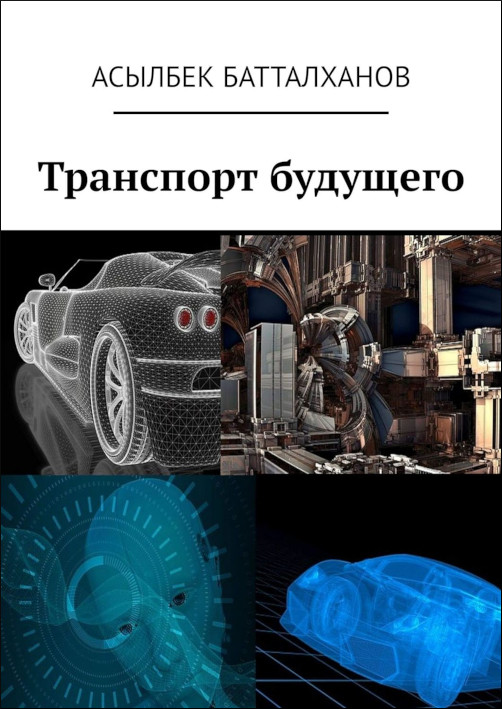
Author: Asylbek Battalkhanov, General Director of AvtoGazAlmaty LLP, Corresponding Member of the National Academy of Sciences of Mechanical Engineering and Transport of the Republic of Kazakhstan.
Publisher: Ridero. Excerpt of the book on the site of the publishing house.
Number of pages: 118.
ISBN: 978-5-4493-7793-7.
The main question the book answers is: what is worth thinking about before choosing a car or starting a business in the transportation market.
Some related questions: will there be a true drone soon? What will it take for mass electrification of cars to succeed? Why is Uber planning to buy tens of thousands of cars? What kind of automobile is becoming mainstream? What new business models have emerged in the transportation market? What technologies will remain fiction in the coming years?
Quotes from the book:
“It is important to distinguish between driver assistance systems (assistants) and autonomous vehicles (drones).”
“The dream of manufacturers is to create a Level 5 automated car, a true drone that will be able to do everything in terms of dynamic driving functions.”
“A community has sprung up in the U.S., with members pushing for the right to repair the vehicles they buy, and in the meantime manufacturers are lobbying to support a ban and putting money into the fight against laws allowing repairs.”
“As Ron Harbour and Jim Schmidt write, back in 1982, General Motors CEO Roger Smith dreamed that factories would be run ‘only by robots and machines that don't need light. ’67. They would be fully automated. Today, Ilon Musk talks about this, but there is still not much change in automobile manufacturing.”
“Any startup consisting of a few programmers, engineers and entrepreneurs can enter the automotive market with their software product, new material or technology.”
“Perhaps the trend to create service in addition to production will be replaced by a trend to create production in addition to service.”
“New challenges require new work rules and new indicators for measuring performance and efficiency. You can't change the business model by leaving the old system of work and old methods of evaluation.”
“If you follow transportation news, you may have noticed that the media constantly reports on the start of new projects, but hardly ever tells you how it all turned out.”
Smart Watch, 2013
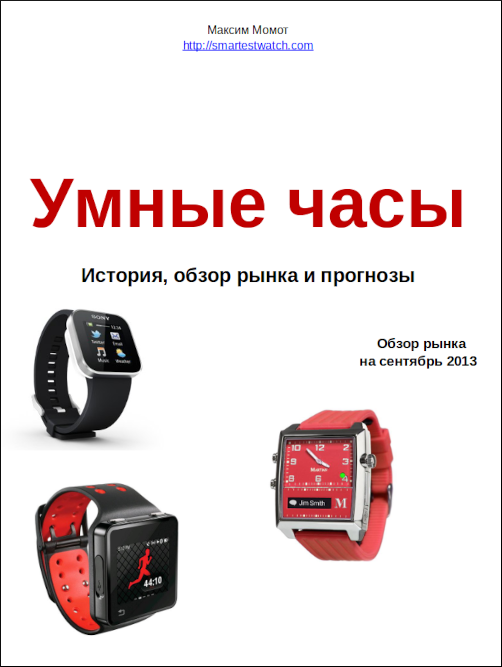
Written by Maxim Momot (WriterByWriter.com, W-r-i-t-e-r.com).
Number of pages: 35 (pdf).
Book on the author's website: Smart Watches. History, market overview and forecasts.
The main question the book answers is: how is the smart watch market evolving.
Some related questions are: what technologies are used in smart watches? Can smart watches replace smartphones? When to buy a smart watch?
Quotes from the book:
"The very first smart watches (or rather their analog) were released on the market back in the 1980s by the famous brand Seiko.”
“The history of smart watches with an operating system began in the distant 2000. Then IBM released the world's first prototype with the Linux operating system.”
“Also worth remembering is the Fossil Wrist PDA, a Palm OS smart watch released in 2003. I'm sure it's a watch that was ahead of its time.”
“Today's smart watches are not smart enough after all. And that's another reason why 2013 can't be the year of the smart watch.”
“The situation in the smart watch market is amazing. There is some demand, but no supply. Yes, not everyone sees the need for smart watches, but there are still more people who want to become happy (or not so happy) owners of this fashionable and convenient gadget every day. And the supply is so scarce that it's almost non-existent.”
“In 2014, big brands will enter the market, which on the one hand will reduce the cost of smart watches, and on the other hand will improve their quality and expand the range. When small Chinese manufacturers also get involved, then we will see a really wide choice and low prices”.
Promotion by Books, 2012

Author: Natalia Tolmacheva (WriterByWriter.com, W-r-i-t-e-r.com).
Number of pages: 26 (pdf).
Book on the author's website: Book Promotion. A practical manual as a marketing tool.
The main question the book answers is: why books help you achieve your marketing goals.
Some related questions: why is it worth writing a book? Why do I call some books “PR books”? How do you figure out who to write for? How do you create value for the reader? Who shouldn't write a book? How is a PR book different from any other book?
Quotes from the book:
“Why is it most effective for various marketing purposes to use application books, that is, practical manuals or hands-on guides?
Because...
“A free manual is much more useful than other types of advertising.”
Anthony Pratkanis, Elliot Aronson, scholars and authors of the world's most authoritative book on the psychology of influence and persuasion
And because.
“Instead of trying to beat the competition - sell more, spend more, sponsor more - try to educate your audience more than your competitors”
Jason Fryde, David Hensson, entrepreneurs and co-authors of the book Rework“”
“Any professional can be useful to ‘mere mortals,’ that is, people who are not professionals in his or her field, but are his or her potential customers (the company's customers), and still partners, employees, and investors in the business.
I emphasize: professional. If you are still new to the profession, you'd better focus on learning theory and informed practice.”
“It is necessary to competently compose a commercial proposal (application for publishing a book), which will convince the publisher that your book is in demand in the book market and will bring profit”.
Personal Financial Management, 2011
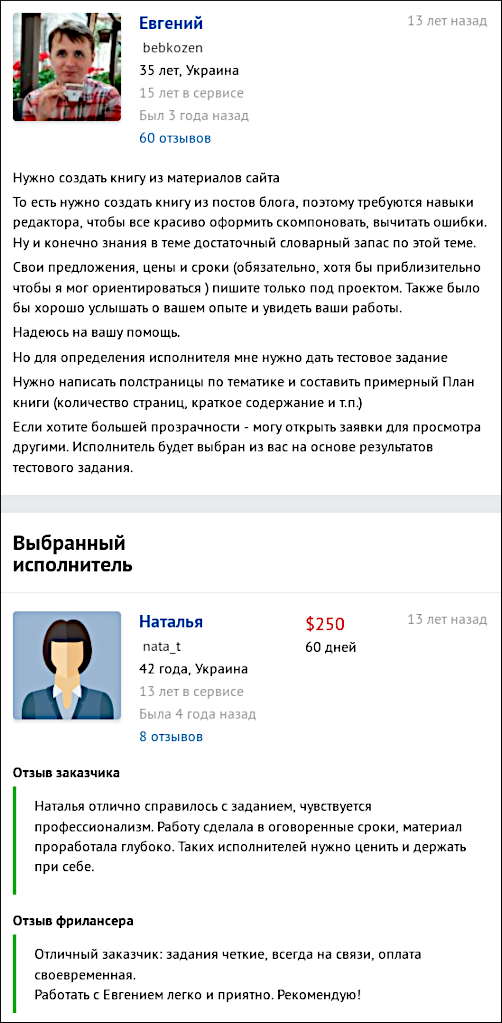
Author: (Information withheld).
Project on Weblancer: order and positive feedback from customer representative.
Writer's task (after discussing the project): study the materials of the site, develop the concept of the book and create the manuscript (including editing the existing texts, finishing the preface, afterword and a few missing chapters). Bonus for the customer: preparation of the application for the publishing house.
Publisher: (Information withheld).
Number of pages: 200.
ISBN: (Information withheld).
The main question the book answers is: how to earn, spend, invest more effectively.
Some related questions: how and why to save money? How to create new sources of income? How to properly upgrade your skills? What should a beginning investor know? How to create useful financial habits? How to reduce financial risks?
Natural Parenthood, 2011

Author and writer: Natalia Tolmacheva (WriterByWriter.com, W-r-i-t-e-r.com).
Years of work on the book: 2010-2011.
Year of the first edition: 2011 (ProstoBook.com Service).
Year of the second (revised) edition: 2013.
Publisher: Genesis. Information about the book on the website of the publisher (the site is blocked for visitors from Ukraine).
Number of pages: 304.
ISBN: 978-5-98563-287-3.
The main question the book answers is: how to take care of young children.
Some related questions are: how to prepare for childbirth? How does breastfeeding affect the health of baby and mom? What are the benefits of co-sleeping? How does separation from mom affect the baby? What are the most favorable conditions for the development and learning of a child in the first years of life? Why is it not necessary to attend kindergarten?
Quotes from the book:
“The habit (and innate need) of people to believe what is generally accepted without questioning it leads to misconceptions becoming tradition. And who would risk questioning the correctness and usefulness of tradition? I believe that in our time only science, scientific methods of cognizing reality, can do that.”
“I tend to believe that natural parenthood emerged in the twentieth century due to the development of science and the general humanization of modern human society. Some “naturalists”, i.e. supporters of natural parenthood (NP) are sure that it is a revived tradition of child rearing, a renewed experience of ancestors. I, on the other hand, have come to the conclusion that almost all good traditions have long been lost, and those that have come down to us are better left in the past (e.g., cruel punishment of children). We know too little about the experience of our forebears in the field of upbringing, and what we know must be cross-checked with the help of science.”
“From the point of view of neurobiology, the cause of aggression is pain (including fear, stress, etc.). This is not just a claim made by psychotherapists (many of us like to say “psychologists made that up” and “it's all nonsense”). It is a scientifically proven fact. The function of aggression is to protect the integrity of one's own body and to defend against pain.”
“It is not the search for pedagogical recipes (what should I do?) that leads to success, but understanding the causes of aggression, fear or violence in certain children under certain conditions [106].
Specialists claim that the most vulnerable and sensitive children are often among the 'difficult' children.”
“Throughout preschool and the beginning of primary school age, the child's brain is mainly engaged in processing sensory information, which it receives through sensations (motor, vestibular, tactile, visual, gustatory, olfactory, auditory) [116].
At this age, the leading channel of perception is the kinesthetic (motor) channel. It is it that supplies the brain with the most information about the surrounding world. For this channel to work properly, the child must be able to move freely (crawl, walk, run, jump), operate with different objects and observe the movements of living objects. The work of other channels of perception (auditory, visual) also depends on the work of the kinesthetic channel, for example, if a child sees and touches a live cat, he will more quickly remember what a “cat” is, than when he will be shown this cat twenty times in drawings.
Created:
May 22, 2024, 10:59 a.m.
Changed:
Oct. 18, 2024, 12:18 p.m.